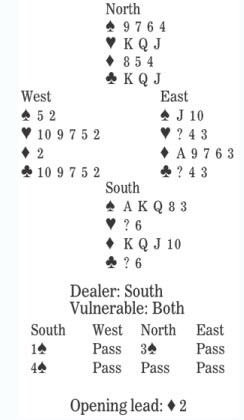 |
|
[Photo provided to China Daily] |
Last week, we looked at when declarer should ruff or overruff, or discard when he could ruff or overruff. Over the next two weeks, let's give the defenders a chance to shine in these areas.
First of all, let's review a defensive technique that should be automatic for any pair out of beginner classes for, say, a year. South is in four spades. West leads his singleton diamond. Surprise, surprise, East wins the trick and returns a diamond for West to ruff. What should West lead next?
In the auction, North is right to make a game-invitational, not game-forcing, response. His hand has the bad 4-3-3-3 hand distribution and eight losers (three spades, one heart, three diamonds and one club), which makes it textbook for a game-invitational sequence. South probably considered slam, but decided that keeping the opponents in the dark was a better idea.
At trick three, West wants to get his partner back on lead so that he can receive a second diamond ruff to defeat the contract. But should he shift to a heart or a club?
As you surely know, East's diamond return at trick two gives the answer. His card transmits a suit-preference signal. If East has the heart ace, he leads back his highest-remaining diamond; here, the nine. Or, if East holds the club ace, he returns his lowest diamond; here, the three.
Now it should be the work of a moment for West to make the correct shift and to receive the lethal second ruff.
Finally, if East does not know which suit he wants led back, he returns his middle diamond at trick two ... and confuses and annoys West!


























 Raymond Zhou:
Raymond Zhou: Pauline D Loh:
Pauline D Loh: Hot Pot
Hot Pot Eco China
Eco China China Dream
China Dream China Face
China Face






